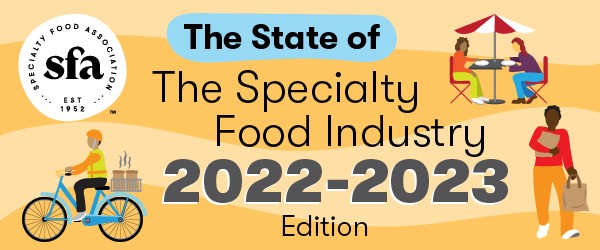The SFA has released its annual State of the Specialty Food Industry Report, revealing that the specialty food market reached total sales of $175 billion in 2021, up 7.4 percent versus 5.8 percent the year before, when foodservice’s steep decline offset outsized gains in brick-and-mortar retail and ecommerce.
The report will be discussed this Sunday, June 12 at 11:15 a.m. at the Summer Fancy Food Show.
"The specialty food market has prospered amid two difficult years, with our latest research showing specialty continues to grow at a faster rate than all food," said Denise Purcell, Specialty Food Association's vice president, content & education. "Growth will continue, but at a slower pace than the industry experienced during the 2020 pandemic-influenced whirlwind of grocery shopping and at-home meal preparation--and will depend on supply chain bandwidth and shifts in challenges like inflation, shipping issues, cost increases, and materials shortages."
The annual State of the Specialty Food Industry research is an examination of market size and sales; dollar and unit sales growth; specialty food category penetration; and 10-year tracking and forecasting in key categories. New this year: sales forecast for retail, foodservice, and ecommerce; video interviews with members of the supply chain; and a closer look at sales and opportunities in specialty perishables departments.
Key Facts and Figures:
Top 10 Categories in Retail Dollar Sales
1. Meat, poultry, seafood (Frozen, refrigerated)
2. Cheese and plant-based cheese
3. Chips, pretzels, snacks
4. Bread and baked goods
5. Coffee and hot cocoa, non-RTD
6. Entrees (Refrigerated)
7. Chocolate and other confectionery
8. Water
9. Desserts (Frozen)
10. Entrees, lunch, dinner (Frozen)
Top 10 Fastest-Growing Categories
1. Tea and coffee RTD (Refrigerated)
2. Creams and creamers (Refrigerated)
3. Entrees (Refrigerated)
4. Breakfast foods (Frozen)
5. Appetizers and snacks (Frozen)
6. Seasonings
7. Pasta (Refrigerated)
8. Fruits and vegetables (Frozen)
9. Sauces, pasta, and pizza (Shelf stable)
10. Soda and carbonated beverages
Insights and Takeaways
The Supply Chain’s Impact on Growth The parts of the industry that will grow in the next few years in part hinge on supply chain bandwidth. Makers continue to report they are unable to properly forecast their sales because they often don’t know what their supplier shipments will look like. Lead times for shipments fluctuate, too, causing production schedule delays. All of this influences how makers formulate their products, as they evaluate which SKUs they can confidently produce, made with ingredients they can reliably source and priced properly to achieve profit despite increased raw material costs.
BIPOC- and Women-Owned Brands in Demand Consumers want more BIPOC- and women-owned brands and retail buyers and foodservice operators are seeking out incubators, brokers, b2b wholesalers and distributors, and even sales consultancies that specialize in supporting and growing these brands. Showcasing these brands has moved far beyond seasonal features to align with observed months like Black History or Women’s History, and will continue to expand.
The Next Retail Formats The pandemic gave retailers insight into the store formats shoppers want next and smaller footprints with minimal human contact are in demand. Expect fast growth of these formats among traditional grocers, who are also reintroducing areas since the COVID scaleback with new ideas.
Plant-Based Challenges The overall plant-based specialty retail market grew 6 percent, exceeding $7.7 billion in 2021, after stellar 26 percent growth in 2020. Plant-based growth has outpaced the entire specialty retail market, which grew 4 percent in 2021 and 20 percent in 2020. However, some plant-based categories were among 12 total that grew specialty sales slower than the entire market in 2021. These include Yogurt and plant-based yogurt; Tofu; Creams and creamers (Shelf stable); Plant-based milk (Refrigerated); and Plant-based milk (Shelf stable). The largest growth gap is with Plant-based meat alternatives (Refrigerated). It grew 34 percent in specialty but 66 percent in the total market. Historically, this category has been composed of 97 percent specialty items, but it changed in the last three years and now non-specialty items are contributing to much of the growth.
Specialty Beverages Grow Faster Than Food During 2020’s initial height of COVID, specialty food grew faster (21 percent) than beverages (16 percent), but that shifted in 2021 as specialty beverages grew twice as fast as food. It comes down to consumers seeing certain products as critical, and others as discretionary. In this instance food was more a consumer priority during the initial phases of COVID but over time, consumers expanded their shopping lists to include more specialty beverage purchases. RTD alcoholic beverages like hard seltzer, hard kombucha, and fermented functional cocktails, in particular, are growing rapidly.
Opportunities in Perishables New this year, the SFA took a closer look at specialty perishable sales, which are expected to reach nearly $33.5 billion in 2022. Perishables (random weight, non-UPC’d specialty items sold in a bakery, cheese, deli, meat and seafood sections) are critical to specialty, both in scale and as a good source of growth. For specialty retailers, perishables departments represent enticing, creative merchandising and execution. Plus they are important centers for emerging food and beverage innovation that may eventually migrate to packaged goods categories. After being challenged by shutdowns during COVID, perishables can expand to better meet consumers’ needs for hot, ready-to-eat, or take-home, heat-and-eat fresh meals; meal kits; sandwiches, side dishes and salads; breakfast foods; confections and desserts; and hot and cold beverages.
Related: Alysia Reiner to Speak at A Fancy New York Pitch Slam; Startup Pavilion to Feature Up-and-Coming Food Makers.

